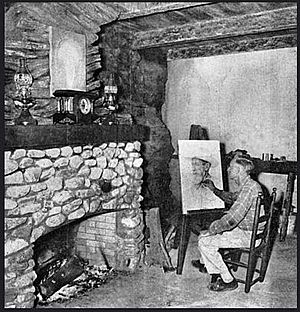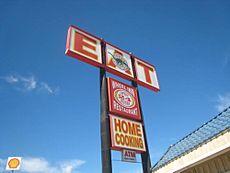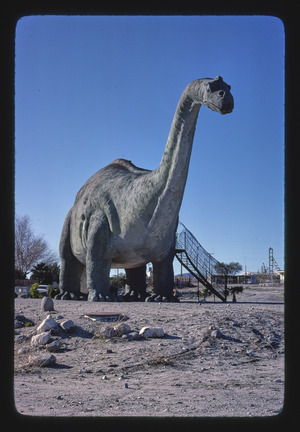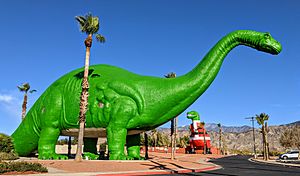Cabazon Dinosaurs facts for kids
Quick facts for kids Cabazon Dinosaurs |
|
|---|---|
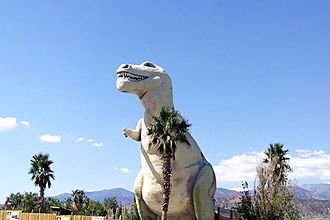 |
|
| General information | |
| Architectural style | Novelty architecture |
| Town or city | Cabazon, California |
| Country | United States |
| Coordinates | 33°55′13″N 116°46′22″W / 33.92028°N 116.77278°W |
| Construction started | 1964 (Dinny) / 1981 (Mr. Rex) |
| Completed | 1975 (Dinny) / 1986 (Mr. Rex) |
| Cost | $300,000 (Dinny) |
| Design and construction | |
| Architect | Claude K. Bell |
| Structural engineer | Gerald Hufstetler |
The Cabazon Dinosaurs are a famous roadside attraction in Cabazon, California. They used to be called Claude Bell's Dinosaurs. This cool spot features two giant dinosaurs made of steel and concrete. Their names are Dinny the Dinosaur and Mr. Rex.
These huge dinosaurs are located west of Palm Springs. You can easily see them from Interstate 10 as you drive by. Dinny, a Brontosaurus, is about 150 feet (46 meters) long. Mr. Rex, a Tyrannosaurus rex, stands about 65 feet (20 meters) tall. Many people know these dinosaurs from their appearance in the 1985 movie Pee-wee's Big Adventure.
Artist Claude Bell started building these dinosaurs in 1964. He wanted to attract more people to his restaurant, the Wheel Inn. Dinny was finished in 1975, and Mr. Rex was completed in 1986. Claude Bell passed away in 1988. His family later sold the property in the mid-1990s. For a while, the attraction became a museum with certain religious ideas, but those materials have since been removed.
Meet the Creator: Claude Bell
Claude K. Bell (1896–1988) was an amazing artist. He started sculpting as a teenager. He would make teddy bears out of sand on the beach in Atlantic City, New Jersey. People gave him tips, which encouraged him to keep going. Soon, he was making a living by creating sand sculptures at fairs all over the country.
In 1947, Walter Knott hired Claude Bell. Bell created concrete sculptures of people sitting on benches at Knott's Berry Farm. He also ran the portrait studio there from 1951 to 1986. Claude, his wife, and his daughter Wendy all worked together, drawing portraits of guests.
Claude Bell bought the land for the dinosaurs in 1946. He paid $5,000 for it. The land was leveled for free as part of a deal. The state needed to remove gravel for a freeway overpass. Bell started living on the land part-time in 1952. He opened his restaurant, the Wheel Inn, there in 1958. The restaurant was open until 2013.
Building the Giant Dinosaurs
Claude Bell began building his first dinosaur, Dinny the Brontosaurus, in 1964. He was inspired by a childhood visit to the Atlantic City Boardwalk. There, he saw Lucy the Elephant, a building shaped like an elephant. He decided he wanted to build something big like that one day.
Bell used steel and cement that were salvaged from the freeway. These materials could not be used for state construction after a flash flood. Bell was allowed to take them if he cleared them from state property.
Dinny was built with a steel frame, like a skeleton. Then, an expanded metal grid was shaped over it to form the dinosaur's body. Bell worked with engineer Ralph Titus to weld the steel "ribs." They then wrapped the structure with wire to create the skin's shape. Bell said, "Everything is shaped in wire – wrinkles in the neck, muscles in the legs." After that, the wire was sprayed with layers of shotcrete, which is a type of concrete.
In 1970, Bell mentioned that Dinny was 45 feet (14 meters) high and 150 feet (46 meters) long. He believed it was "the first dinosaur in history... to be used as a building." He originally wanted Dinny's eyes to glow and its mouth to spit fire at night. He thought it would "scare the dickens out of a lot of people." However, these features were never added.
Dinny was completed in 1975. The project cost was estimated to be over $100,000 at that time. By 1986, Bell estimated the cost at $250,000. A 1999 article reported a cost of $300,000.
Bell planned to build a second dinosaur, a Tyrannosaurus rex, as early as 1970. He said the first one took a long time because they had to make their own special tools. He expected the second one to be much faster. By November 1980, scaffolding for the second sculpture was visible. A year later, the structure and wire frame were ready for cement. The Tyrannosaurus sculpture was designed with a channel in its tail for a slide. However, Bell worried the slide would be too steep to be safe.
Bell had plans for a third sculpture, a woolly mammoth, and a prehistoric garden. Sadly, he passed away in 1988 before these could be completed.
The Dinosaurs Today
After Claude Bell's death, his wife Anna Marie wanted to create an amusement park. In 1992, there were plans for a 60-acre attraction called Dinosaur Village. It would have featured 12 animated dinosaurs, plus the existing ones. There were also ideas for an arcade, rides, and a theater. However, these plans did not happen. By 1995, Gary Kanter bought the property.
In 1996, plans were approved to expand the Cabazon dinosaur site. This included land for restaurants, a museum, a gift shop, and a motel. Gary Kanter had a vision to turn the area into a children's science museum.
For a period, the gift store inside Dinny sold toys and T-shirts with messages that questioned evolution. There were also new dinosaur sculptures and signs promoting certain religious views. However, Bell's original artwork showing human evolution was left untouched.
Since 2017, visitors have reported that these religious materials have been removed from the attraction. The Kanters still own and operate the site as of 2025.
Today, the Cabazon Dinosaurs attraction also has an open-air museum. It features fiberglass and robotic dinosaurs. Other fun activities include a sand pit where visitors can try a "dino dig." There is also a sluice for panning for gemstones and fossils.
See also
- List of dinosaur parks
- Novelty architecture
- Wall Drug – a tourist attraction in South Dakota with a large concrete dinosaur


